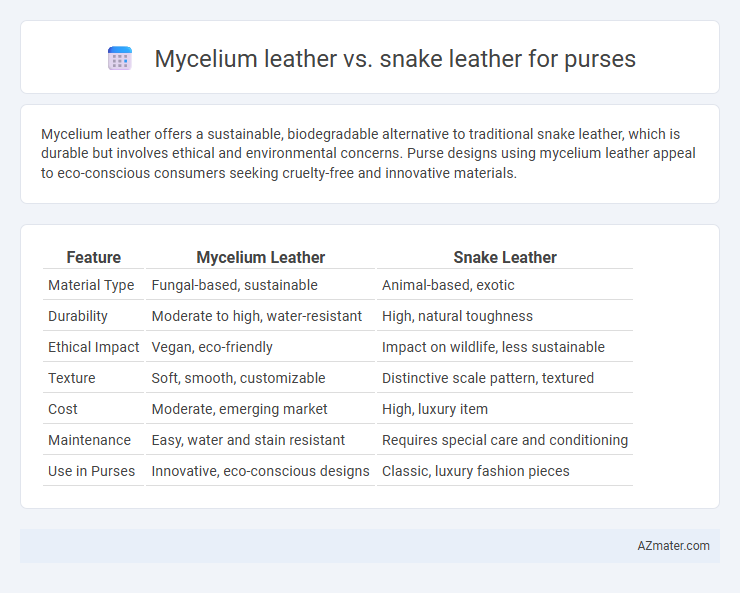Mycelium leather offers a sustainable, biodegradable alternative to traditional snake leather, which is durable but involves ethical and environmental concerns. Purse designs using mycelium leather appeal to eco-conscious consumers seeking cruelty-free and innovative materials.
Table of Comparison
| Feature | Mycelium Leather | Snake Leather |
|---|---|---|
| Material Type | Fungal-based, sustainable | Animal-based, exotic |
| Durability | Moderate to high, water-resistant | High, natural toughness |
| Ethical Impact | Vegan, eco-friendly | Impact on wildlife, less sustainable |
| Texture | Soft, smooth, customizable | Distinctive scale pattern, textured |
| Cost | Moderate, emerging market | High, luxury item |
| Maintenance | Easy, water and stain resistant | Requires special care and conditioning |
| Use in Purses | Innovative, eco-conscious designs | Classic, luxury fashion pieces |
Introduction to Mycelium and Snake Leather
Mycelium leather, derived from the root structure of mushrooms, offers a sustainable and biodegradable alternative to traditional animal hides, making it increasingly popular in eco-friendly purse designs. Snake leather, known for its distinctive scale patterns and durability, has been a luxurious material choice for handbags, prized for its unique texture and exotic appeal. Both materials present contrasting benefits in terms of environmental impact and aesthetic value, shaping consumer preferences in the fashion industry.
Production Process: Mycelium vs Snake Leather
Mycelium leather is produced through a sustainable process where fungal mycelium fibers are cultivated on agricultural waste, then dried and treated to form a durable, leather-like material with minimal environmental impact. In contrast, snake leather involves the harvesting of snake skins, which requires animal farming or wild capture, tanning, and chemical processing that can be resource-intensive and less eco-friendly. The mycelium production process offers a renewable, cruelty-free alternative, while snake leather relies on traditional leathercraft techniques involving animal-derived raw materials.
Environmental Impact Comparison
Mycelium leather significantly reduces environmental impact compared to snake leather, as it is cultivated from fungi without animal harm or deforestation. The production of mycelium leather consumes less water and energy, and it generates fewer greenhouse gas emissions than traditional snake leather, which involves intensive farming and chemical tanning processes. Mycelium leather's biodegradability and sustainable sourcing make it a more eco-friendly choice for purses, promoting a circular fashion economy.
Durability and Longevity
Mycelium leather offers impressive durability and resistance to wear, often outperforming traditional materials due to its dense fiber structure and natural flexibility, making it ideal for long-lasting purses. Snake leather, while luxurious and unique in texture, tends to be more delicate and prone to scratches and environmental damage, requiring careful maintenance to preserve its longevity. Choosing mycelium leather ensures a sustainable, durable option with enhanced resilience, whereas snake leather provides exotic aesthetics at the cost of reduced durability.
Texture and Aesthetic Appeal
Mycelium leather offers a smooth, matte texture with subtle natural patterns, providing a modern and sustainable aesthetic ideal for minimalist purse designs. Snake leather is characterized by its distinctive scale patterns and glossy finish, delivering a luxurious and exotic look with a tactile, raised texture. The choice between mycelium and snake leather hinges on preference for eco-friendly innovation versus traditional opulence in purse craftsmanship.
Cost and Market Availability
Mycelium leather offers a cost-effective alternative to traditional snake leather, with lower production expenses due to sustainable, lab-grown processes that reduce resource use. Snake leather remains a luxury material with higher market prices and limited availability, driven by rarity and regulations on exotic animal trade. Mycelium leather is increasingly accessible in mainstream markets, appealing to eco-conscious consumers seeking affordable, cruelty-free purses.
Ethical and Animal Welfare Considerations
Mycelium leather offers a sustainable and cruelty-free alternative to traditional snake leather, eliminating the need for animal exploitation and harsh tanning chemicals. Snake leather involves harvesting scales from reptiles, often leading to animal stress and unethical farming practices. Choosing mycelium leather supports animal welfare and environmental sustainability while providing durable, biodegradable material for purses.
Maintenance and Care Requirements
Mycelium leather requires minimal maintenance, needing only occasional wiping with a damp cloth and avoiding prolonged exposure to direct sunlight to prevent discoloration. Snake leather purses demand more intensive care, including regular conditioning with specialized leather oils to maintain flexibility and prevent cracking. Both materials benefit from storage in a cool, dry place away from humidity, but snake leather is particularly sensitive to environmental changes, requiring more diligent upkeep to preserve its texture and appearance.
Consumer Preferences and Trends
Mycelium leather is gaining popularity among eco-conscious consumers due to its sustainability, biodegradability, and cruelty-free production, appealing to those who prioritize ethical fashion. Snake leather remains favored for its unique texture, durability, and luxury appeal, attracting buyers seeking traditional exotic materials and status symbols. Current trends show a growing consumer shift towards innovative, plant-based materials like mycelium leather as demand for sustainable alternatives rises in the luxury purse market.
Future Prospects of Leather Alternatives
Mycelium leather and snake leather represent two distinct approaches in the evolving leather market, with mycelium leather offering sustainable and eco-friendly advantages through its rapid, low-resource cultivation using fungal roots. Snake leather, while prized for its exotic appearance and durability, faces challenges regarding animal welfare concerns and regulatory restrictions, limiting its long-term viability. The future prospects heavily favor mycelium leather due to increasing consumer demand for cruelty-free, biodegradable materials, and advancements in biotechnology that enhance its texture and durability, positioning it as a promising alternative for purse manufacturing.

Infographic: Mycelium leather vs Snake leather for Purse
 azmater.com
azmater.com